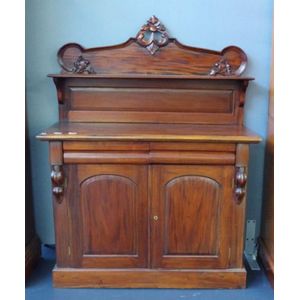William IV Mahogany Chiffonier Cabinet
You must be a subscriber, and be logged in to view price and dealer details.
Subscribe Now to view actual auction price for this item
When you subscribe, you have the option of setting the currency in which to display prices to $Au, $US, $NZ or Stg.
- Column - An architectural feature sometimes used for decorative effect and sometimes as part of the supporting construction. Columns should generally taper slightly towards the top. They may be plain or decorated with carving, fluting or reeding. Columns may be fully rounded or, more commonly, half-rounded and attached with glue, screws or pins to the outer stiles of doors, or the facing uprights on cabinets and bureaux.
- Gothic Style, Furniture - Gothic style furniture refers to pieces that are designed and crafted in the Gothic architectural and decorative style that was popular in Europe from the 12th to the 16th centuries. This style of furniture is characterised by its elaborate and ornate details, as well as its use of dark and heavy woods, such as oak and walnut.
Gothic style furniture often features intricate carvings and embellishments, including pointed arches, quatrefoils, and tracery. The style also frequently incorporates elements such as coats of arms, shields, and religious symbols. Gothic furniture often has a heavy and substantial appearance, and the pieces are often finished with a dark stain to accentuate the detailed carving and embellishments.
The furniture items can be quite large and imposing, and they are often used as statement pieces in large rooms. Gothic furniture can be a striking and dramatic addition to any space, and it is often appreciated by those who have an interest in medieval and historical design. - Gallery - On furniture, a gallery is a small upright section, frequently pierced and decorated, around the tops of small items of furniture, such as davenports, side tables, and so forth. Galleries are made in brass or bronze,and be fretted, pierced or solid timber. A three-quarter gallery is one that surrounds three of the four sides of a table, desk or other top.
- Corbel - An architectural term for a support for a projecting bracket, ostensibly supporting a beam or horizontal feature, but used in bookcases, sideboards and chests as a decorative element. Corbels are often carved with acanthus or other scrolling decoration.
- William Iv - William IV was King of the United Kingdom and King of Hanover from 26 June 1830 until his death in 1837, and in English furniture design it represented the brief period between the end of the Regency period, and the beginning of the Victorian period.
- Mahogany - Mahogany is a dense, close grained red-coloured timber from the West Indies and Central America. It was first imported into Europe in the the early 18th century and its use continued through the 19th century. It was popular for furniture making because of its strength, the wide boards available, the distinctive grain on some boards, termed flame mahogany and the rich warm colour of the timber when it was polished.. The "flame" was produced where a limb grew out from the trunk of the tree, and this timber was usually sliced into veneers for feature panels on doors, backs and cornices.
Some terms used to describe mahogany relate to the country from which it originally came, such as "Cuban" mahogany, "Honduras" mahogany etc. However unless the wood has been tested the names assigned are more a selling feature, rather than a true indication of the timber's origin. - Turning - Any part of a piece of furniture that has been turned and shaped with chisels on a lathe. Turned sections include legs, columns, feet, finials, pedestals, stretchers, spindles etc. There have been many varieties and fashions over the centuries: baluster, melon, barley-sugar, bobbin, cotton-reel, rope-twist, and so on. Split turning implies a turned section that has been cut in half lengthwise and applied to a cabinet front as a false decorative support.
This item has been included into following indexes:
-
cabinets, period or style
- Gothic revival 44
- William IV 96
- chiffoniers (small sideboards), period or style - William IV 21
- chiffoniers (small sideboards), timber - mahogany 130
- sideboards - 18th century English mahogany 82
Visually similar items

Victorian style mahogany chiffonier, 155 cm height, 118 cm width, 46 cm depth

A mahogany chiffonier, two door, one drawer with galleried top 122 x 109 x 42 cm

Victorian mahogany chiffonier with 2 drawers & 2 doors, 103 cm wide, 37 cm deep, 129 cm high approx

An Italian walnut side cabinet, 17th century. rectangular, with a single frieze drawer above a panelled door flanked by reeded styles, raised on a plinth base with lions paw feet, 64 x 91.5 x 33 cm Provenance: de-accessioned from the collections of the Nat
